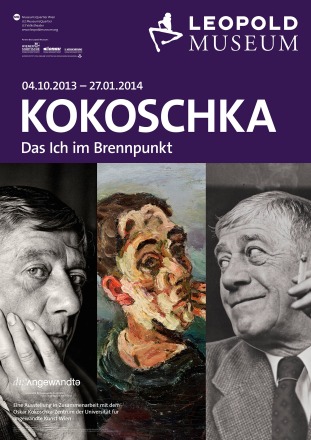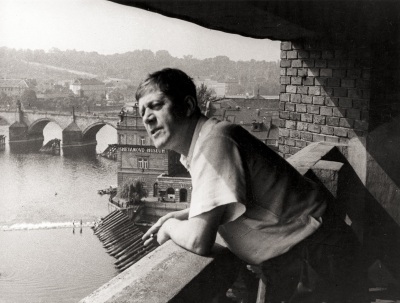by Paula Terán
Vienna, from 4. October 2013 to 27. January 2014
Three impressive artists represent the Austrian Modernism, full of innovative and radical ideas: Gustav Klimt (1862–1918), Oskar Kokoschka (1886–1980) and Egon Schiele (1890–1918).
Unlike Klimt and the young Schiele, who died in 1918, Oskar Kokoschka lived until 1980 so is the only one of these artists whose oeuvre stretched far into the 20th century.
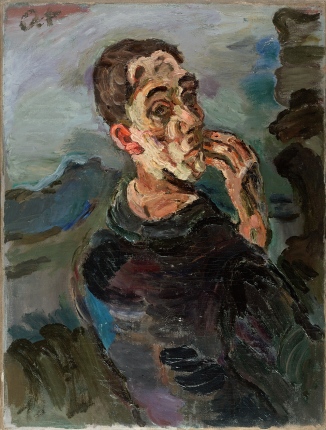
Self-Portrait, One Hand Touching the Face, 1918/19, Oskar Kokoschka. Oil on canvas. Leopold Museum, Vienna. ©Fondation Oskar Kokoschka/VBK, Wien/Vienna
Throughout his life, he was photographed time and again and with this exhibition, the Leopold Museum intends to illustrate, in a different way, by the dialogue between photography and painting, the different contributions that these three artists, and Kokoschka in particular, made to the art of the 20th century.
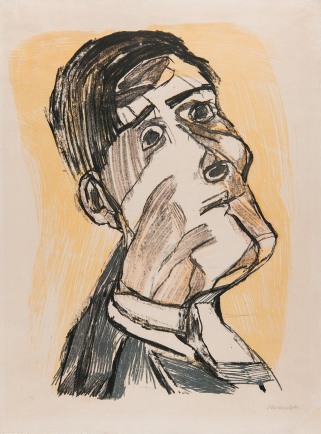
Self-Portrait from two Sides, 1923, Oskar Kokoschka. Chalk lithography, four tones. Museum der Moderne Salzburg. ©Fondation Oskar Kokoschka/VBK, Wien/Vienna 2013
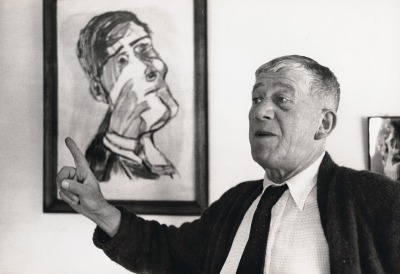
Oskar Kokoschka in front of the painting Self-Portrait from two Slides in Villeneuve, 1955. Photography mounted on cardboard. University of Applied Arts Vienna, Oskar Kokoschka-Zentrum. ©René Burri/Magnum Photos
The exhibition is a cooperation between the Leopold Museum and the Oskar Kokoschka-Zentrum of the University of Applied Arts in Vienna, which houses over 5.000 Kokoschka photograhps, given by his widow Olda after the artist’s death.
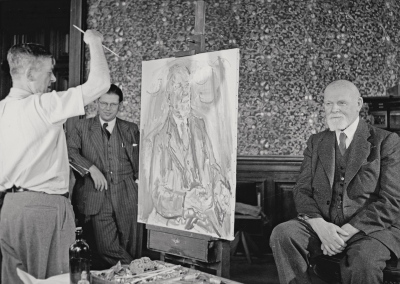
Oskar Kokoschka portraying Mayor Theodor Körner at the Vienna town hall, with coty councelor in charge of cultural affairs Viktor Matejka in the background. Gelatin silver print. University of Applied Arts Vienna, Oskar Kokoschka-Zentrum. ©Wiener Stadt und Landesarchiv, Fotos des Presse und Informationdienstes
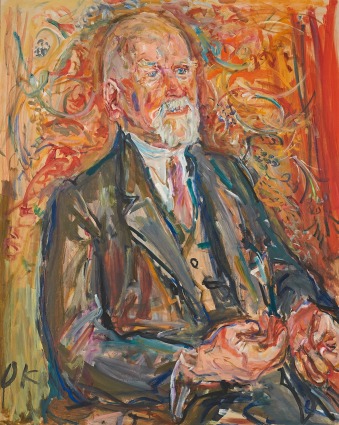
Federal President Theodor Körner as Mayor of Vienna, 1949, Oskar Kokoschka. Oil on canvas. Kunstmuseum Linz. ©Fondation Oskar Kokoschka/VBK, Wien/Vienna 2013
Kokoschka was controversial and often provocative not only as an artist but also as a person. He was considered an ’enfant terrible’ in his early years, and then considered as a prominent ‘degenerate’ artist during the National Socialist era not just for his art but also for his open opposition to the regime.
As the curator of the exhibiton, Tobias G. Natter, points out, the »Leopold Museum’s relationship with Kokoschka’s oeuvre is highly complex. On the one hand, there is the Leopold Museum with its focus on Schiele and on the other, there is Kokoschka who jealously tried to torpedo Schiele’s international breakthrough from the 1960s onwards, vilifying him as a ›pornographer‹ and a copyist on more than one occasion«.
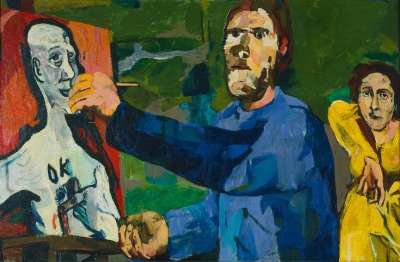
The Painter II (Painter and Model II), 1923, Oskar Kokoschka. Oil on canvas on board. Saint Louis Art Museum. ©Fondation Oskar Kokoschka/VBK, Wien/Vienna 2013
The collector Rudolf Leopold, however, felt the search for quality in 20th century Austrian art to be more important than the artists’s criticism of his younger colleague and the museum houses what are, according to Tobias G. Natter, two of the artist’s most important paintings: »The self-portrait painted shortly after the end of World War I in 1918/19,a difficult period for the artist marred by self-doubt and inner turmoil, as well as the Dolomite landscape Tre croci from 1913, a moonlit scene influenced by the flaring chromaticity of El Greco and Tintoretto. The latter work was created in happier times, before the outbreak of the war, during a trip to the South Tyrolean mountains that Kokoschka took with the highly coveted ‘femme fatale’ Alma Mahler«.
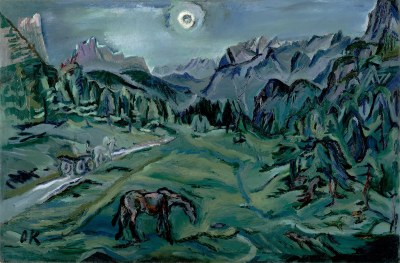
Tre Croci – Dolomite Landscape, 1913, Oskar Kokoschka. Oil on canvas. Leopold Museum, Vienna. ©Fondation Oskar Kokoschka/VBK, Wien/Vienna 2013
The exhibition shows approximately 220 photographs showing the artist’s professional and private life, in dialogue with the artist life’s work included in 32 paintings, 20 drawings, lithographs and posters by Kokoschka.
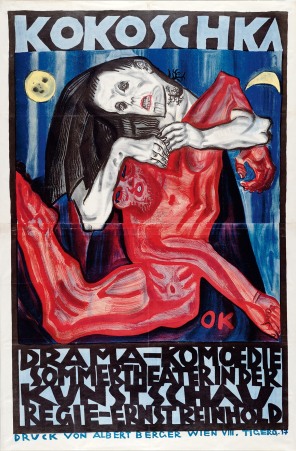
‘Pietà’. Poster for the play Murderer, the Hope of Women at the Inernationale Kunstschau 1909. ©Fondation Oskar Kokoschka/VBK, Wien/Vienna 2013
As usual, some useful information for your visit:
- Leopold Museum website: http://www.leopoldmuseum.org/en
- Dates and opening hours for the exhibition: from 4 October 2013 to 27 January 2014. Daily except Tuesday, from 10.00h to 18.00h; Thursday from 10.00h to 21.00h. Closed on Tuesdays.
- Ticket Prices and Sales: General: 12€; students with ID (up to age 28): 7€; Children up to 7: free.
****************************************************************************************************************
Museo Leopold: ‘Kokoschka. The Self in Focus’. Viena, del 4. Octubre 2013 al 27. Enero 2014.
Tres impresionantes artistas representan el Modernismo austriaco, llenos de innovación e ideas radicales: Gustav Klimt (1862–1918), Oskar Kokoschka (1886–1980) y Egon Schiele (1890–1918).
A diferencia de Klimt y del joven Schiele, quienes murieron en 1918, Oskar Kokoschka vivió hasta el año 1980 por lo que fue el único cuya obra se extendió a lo largo de casi todo el siglo XX.
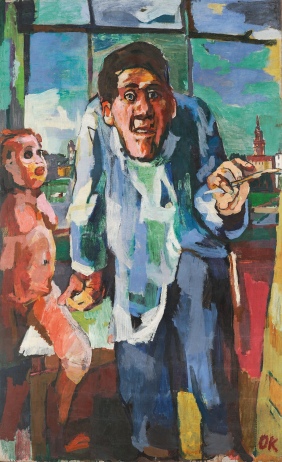
Self-Portrait at the Easel, 1922, Oskar Kokoschka. Oil on canvas. Colección Leopoldo II. ©Fondation Oskar Kokoschka/VBK, Wien/Vienna 2013
A lo largo de su vida, Kokoschka fue fotografiado en numerosas ocasiones y con esta exposición el Museo Leopold quiere ilustrar, de manera novedosa, mediante el dialogo entre la fotografía y la pintura, las diversas contribuciones que estos artistas, y Kokoschka en particular, hicieron al arte del siglo XX.
La exposición es una cooperación entre el Museo Leopold y el Centro Oskar Kokoschka de la Universidad de Artes Aplicadas de Viena, que posee más de 5.000 fotografías de Kokoschka que fueron donadas por su viuda Olda tras la muerte del artista.
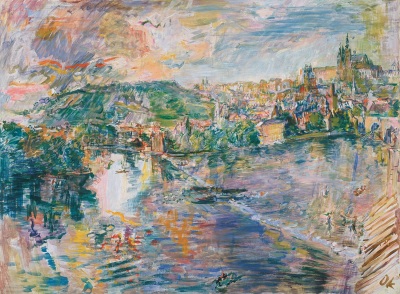
Prague, View from the Moldova Pier IV, 1936, Oskar Kokoschka. Oil on canvas. The Phillips Collection, acquired 1938. ©Fondation Oskar Kokoschka/VBK, Wien/Vienna 2013
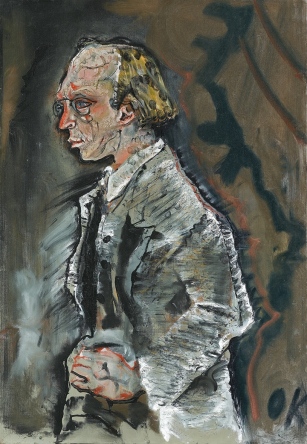
Portrait Herwarth Walden, 1910, Oskar Kokoschka. Oil on canvas. Staatsgalerie Stuttgart. ©Fondation Oskar Kokoschka/VBK, Wien/Vienna 2013
Sin embargo el coleccionista Rudolf Leopold, creyó que la búsqueda de arte austriaco de calidad del siglo XX era más importante que la actitud crítica de Kokoschka hacia Schiele por lo que el Museo Leopold posee las que según Tobias G. Natter son dos de las obras más importantes del artista: »El autorretrato que pintó tras la I Guerra Mundial en 1918/19, un periodo difícil en el que se encontraba sacudido por las dudas acerca de sí mismo y la agitación interna, y el paisaje dolomita Tre Croci de 1913, una escena de luna claramente influenciada por el resplandor cromático de El Greco y Tintoretto. Éste trabajo fue creado en tiempos más felices, antes del comienzo de la guerra, durante un viaje al sur de las montañas del Tirol, que Kokoschka hizo en compañía de la codiciada ‘femme fatale’ Alma Mahler».
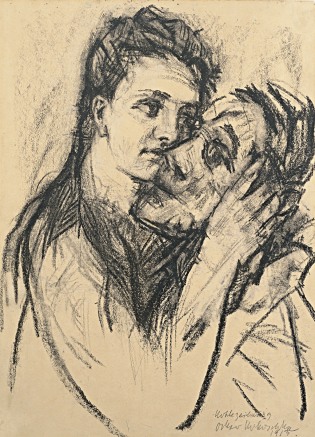
Alma Mahler and Oskar Kokoschka, 1913, Oskar Kokoschka. Carboncillo y tiza blanca sobre papel. Leopold Museum, Viena. ©Fondation Oskar Kokoschka/VBK, Wien/Vienna 2013
La exposición incluye aproximadamente 200 fotografías que muestran la vida profesional y personal del artista, en diálogo con su trabajo, del que se incluyen 32 pinturas, 20 dibujos, litografías y posters realizados por Kokoschka.
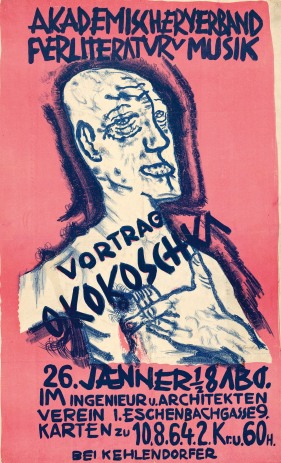
Poster para una conferencia en la ‘Asociación Académica para la Literatura y la Música’, 1911. ©Fondation Oskar Kokoschka/VBK, Wien/Vienna 2013
Como es habitual, aquí se incluye alguna información útil para la visita:
- Página web del Museo Leopold: http://www.leopoldmuseum.org/en
- Fechas y horario de apertura de la exposición: del 4 de octubre 2013 al 27 de enero 2014.
- Diariamente, excepto los martes de 10.00h a 18.00h; jueves de 10.00h a 21.00h. Martes cerrado.
- Tarifas y venta de entradas: General: 12€; estudiantes (con DNI y hasta 28 años): 7€; menores hasta los 7 años: entrada gratuíta.

